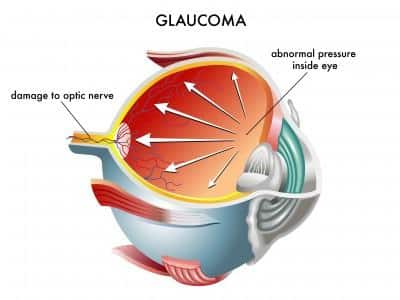
Intraocular Pressure
The elevated intraocular pressure places stress on many parts of the eye. The part of the eye that is most vulnerable to increased pressure is the “optic nerve.” Elevated intraocular pressure causes damage to the optic nerve by two mechanisms.
- The first mechanism is by “mechanical” compression of the nerve itself. In this mechanism the fibers of the nerve are actually “crushed” by the elevated pressure, this would be analogous to stepping on an electrical cord with a shoe and crushing the wires within the cord. Damage caused to the fibers of the optic nerve is what we call glaucoma.
- The second mechanism by which the optic nerve is damaged is called the “vascular mechanism.” In this instance, the blood vessels that supply the nerve with blood become compressed. Compression of these blood vessels prevents the blood that contains oxygen and nutrients from reaching the optic nerve cells. The optic nerve cells become “starved” for blood. If the cells of the optic nerve do not receive adequate blood flow, they can die off, and this optic nerve cell death is also what we call glaucoma. Thus, optic nerve cell death can occur by two separate mechanisms.
These mechanisms of optic nerve cell death are both mechanical and vascular. Both of these mechanisms of optic nerve cell death are the consequence of elevated eye pressure. Therefore, treatment of glaucoma is aimed at lowering the eye pressure.
The optic nerve is very much like a fiber-optic cable, connecting the eye to the brain. The eye is like a camera, which captures images. Information about the image is transferred from the eye to the brain via the optic nerve. The brain interprets and processes this information. The result of this processing is “sight.” Damage to the optic nerve interrupts communication between the eye and the brain thereby leading to sight loss. Thus, glaucoma is defined as “optic nerve damage.” In most instances, glaucoma is caused by elevated intraocular pressure. Elevated intraocular pressure occurs because the eye loses its ability to properly drain the aqueous fluid.

